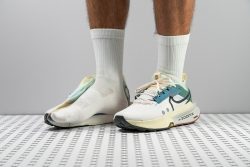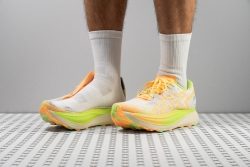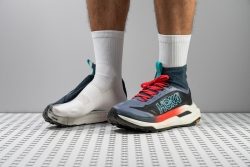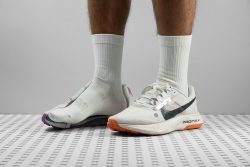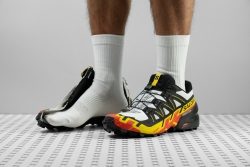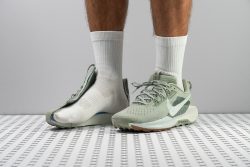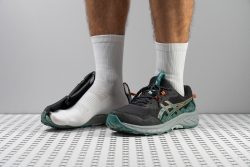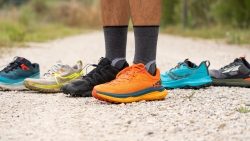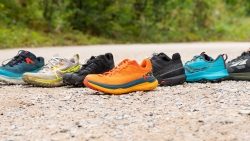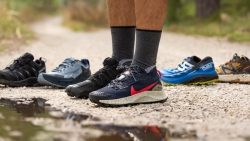7 Best Trail Running Shoes in 2025
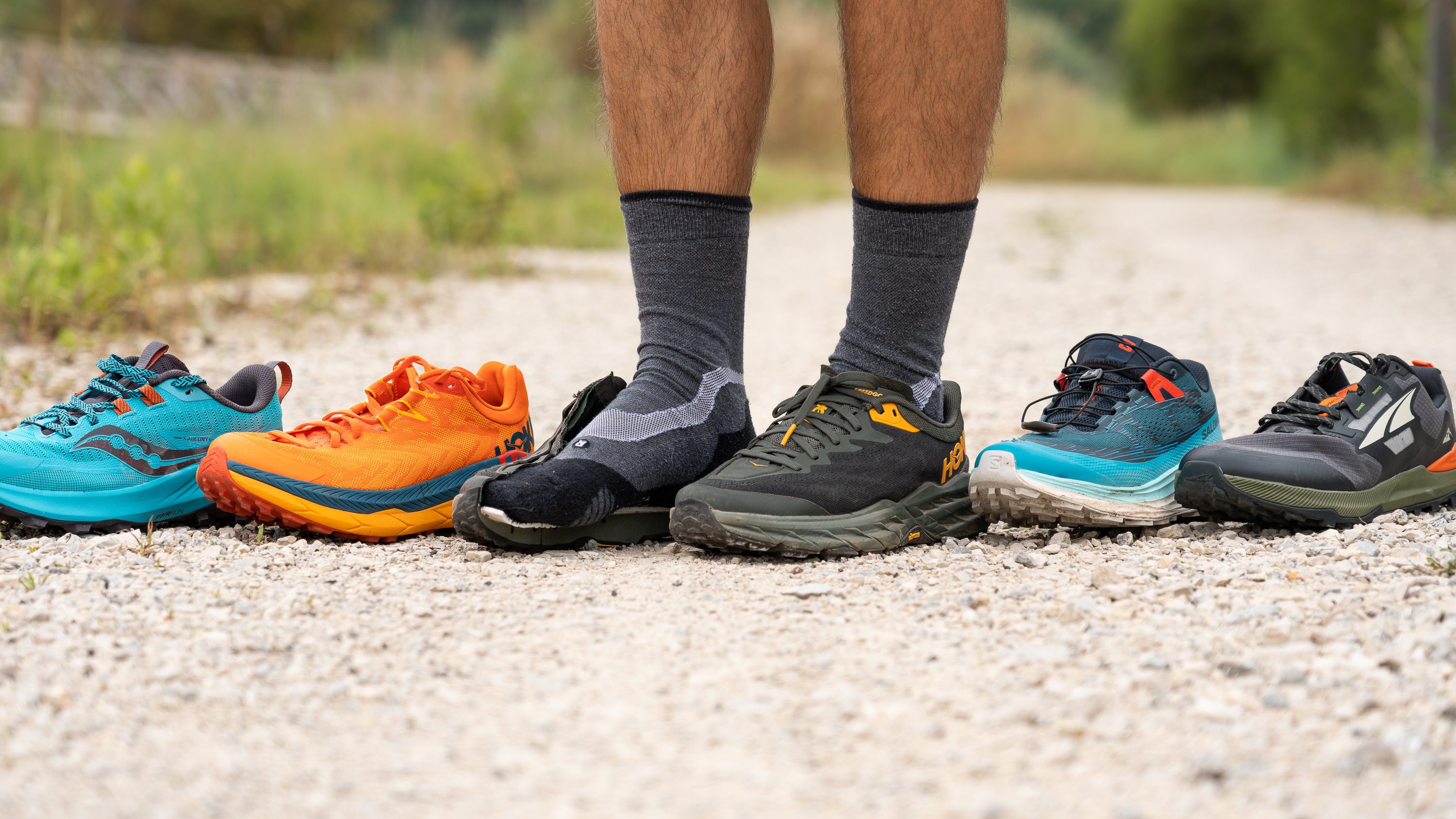
We buy shoes ourselves. We earn commissions when you buy through us, at no extra cost. Why trust us
Some trail shoes are created for the harshest off-road challenges, like rocks, mud, snow, and branches. They keep you protected and surefooted. Others are made for the more urban-ready conditions and are comfortable enough to switch from roads to trails.
After rigorously testing the shoes on the trails and in our lab, we have listed our top recommendations in several categories.
And if you want to dive into the nitty-gritty of selecting the best pair for your needs, skip right to our guide on trail shoes.
How we test trail running shoes
To save you time, we spend hours scrutinizing every single shoe release. As an independent shoe testing lab, we purchase all trail shoes with our own money to stay unbiased.
- We cut shoes into pieces so we can observe and test the shoes and their components in a more in-depth manner
- We take these shoes on trails, gravel roads, single tracks, mud, rocks and slippery slopes while covering numerous uphills and downhills
- We measure over 30 different parameters far beyond weight and stack height, such as traction, flexibility, and shock absorption
Instead of “durable” or “comfortable,” we give you concrete data that puts each trail shoe up against hundreds of others. The best trail shoes make it here.
Best trail running shoes overall
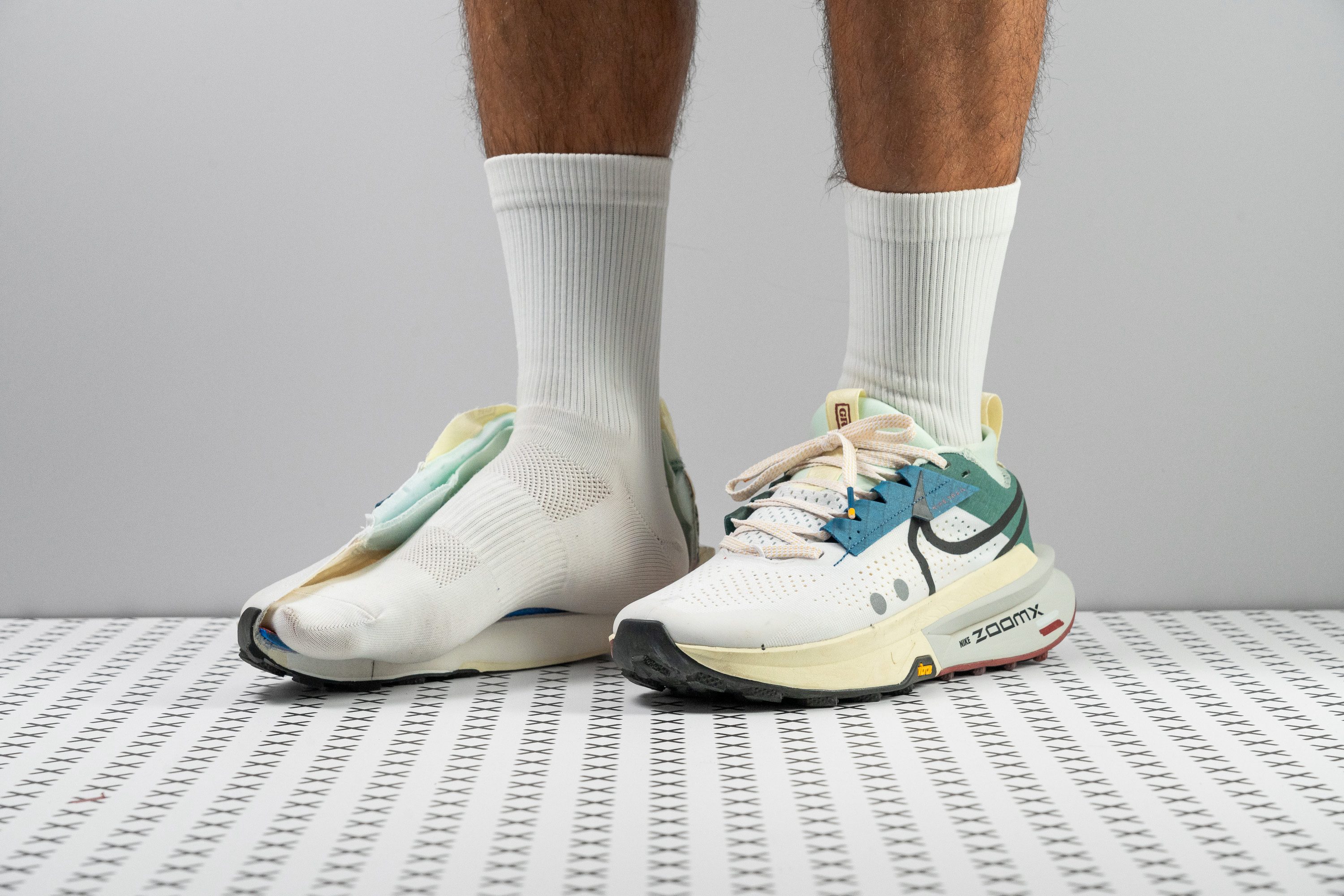
























































What makes it the best?
We ran through beaten paths effortlessly in the Nike Zegama 2. It ticks all the boxes of a supportive trail shoe with its effortless ride, reliable traction, and durable build. This shoe allows us to confidently conquer the wilderness with comfort and ease—cementing its position as our ultimate trail running shoe.
We can go fast and far in this shoe with its superior ZoomX midsole that makes the ride more enjoyable. It’s both plush and bouncy, saving our legs from feeling fatigued. Our durometer measurement shows a soft 14.5 HA, 36.1% softer than the average trail shoe. Further inspection revealed this superfoam is shielded by a thin 14.0 HA carrier foam.
Zegama 2 aced its Vibram Megagrip outsole with 4.0-mm deep Traction Lugs that bite through any surface condition—dirt, mud, and wet pavements. Not only that, it’s highly durable too, showing only a minor 0.8 mm dent in our Dremel test. This confirms it’s tough enough to handle abrasions.
Additionally, Zegama 2 excelled in our heel and upper durability tests with remarkable scores of 5/5 and 4/5, respectively. This leaves us in awe as shoes rarely ace all our lab durability tests.
However, all the comfort and durability come at the expense of weight. At 10.7 oz (302g), it’s less ideal for quick runs and competitions.
Pros
- More ZoomX bouncy foam!
- Vibram Megagrip outsole
- Spacious upper
- Exceptional durability
- Superb wet condition traction
- Ideal for midfoot and forefoot strikers
- Ready for long-distance running
- Suitable for hiking too
Cons
- Could be lighter
- Not ideal for heel strikers
Trail running shoes with the best shock absorption
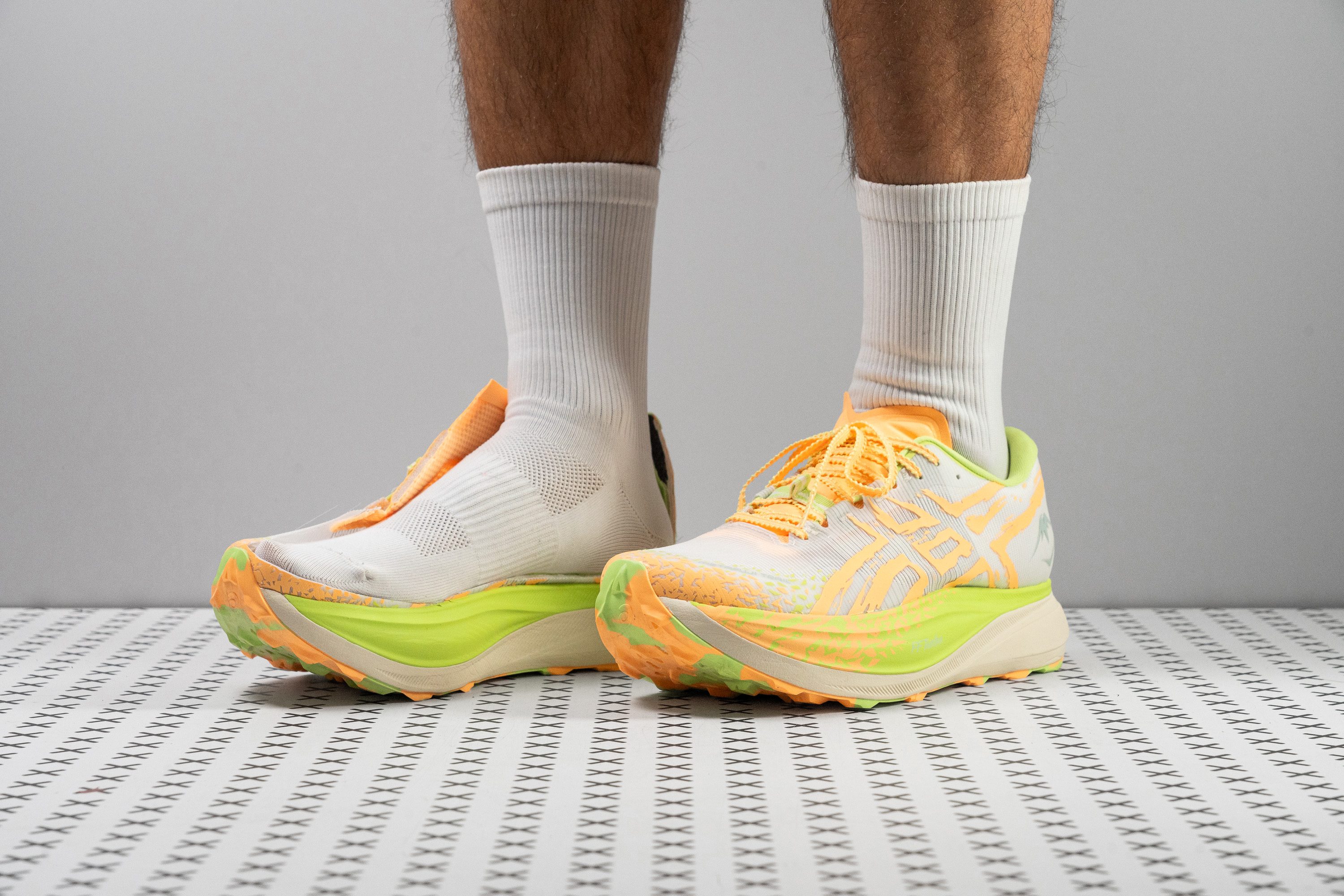
















































What makes it the best?
Our outdoor excursions felt divine with the ASICS Metafuji Trail delivering the best shock absorption among trail running shoes we tested in and out of the lab. It delivers enhanced joint protection through its maximum cushioning and offers a surprisingly lightweight ride that makes any terrain feel effortless, all while providing the reliable grip we need to stay secure.
We measured the behemoth stack height at a limitless 44.7/34.4 mm, leaving no traces of harsh debris underfoot. Not only that, the Metafuji Trail reduces the forces of landing because its cushion can absorb impact much better than average. We recorded high shock absorption scores of 153 SA in the heel and 122 SA in the forefoot, which are 25.4% and 20.8% above average, respectively. On foot, we melted away in its plush sensation.
What’s impressive is how this maximalist showed up with a 9.1 oz (258g) figure on our scale. Weighing 10.7% below average, it delivers an incredibly speedy and agile ride.
In order to maintain our footing during descents and steep turns, the ASICSGRIP does its job of standing its ground well. In our traction test, we recorded an unbelievably high 0.80 rating, making it 33.3% grippier than average. It has shallow 2.7 mm lugs that shine best in well-maintained trails and gravel roads.
Unfortunately, the toebox has a tight fit, which may restrict runners planning to use the Metafuji Trail for ultras. We recommend those with wide or swollen feet to find a more accommodating shoe.
Pros
- Exceptional shock absorption
- Amazing ASICSGRIP outsole
- High-end build quality
- Ideal for narrow feet
- Lightweight for a trail shoe
- Fast-rolling forefoot rocker
- Ideal for easy, flat-ish ultras
- Outstanding upper with top ventilation
- Record-breaking stack height
Cons
- FF Blast+ foam limits energy return
- Expensive
- Minimal stability
- Delicate upper prone to tearing
Trail running shoes with the best energy return
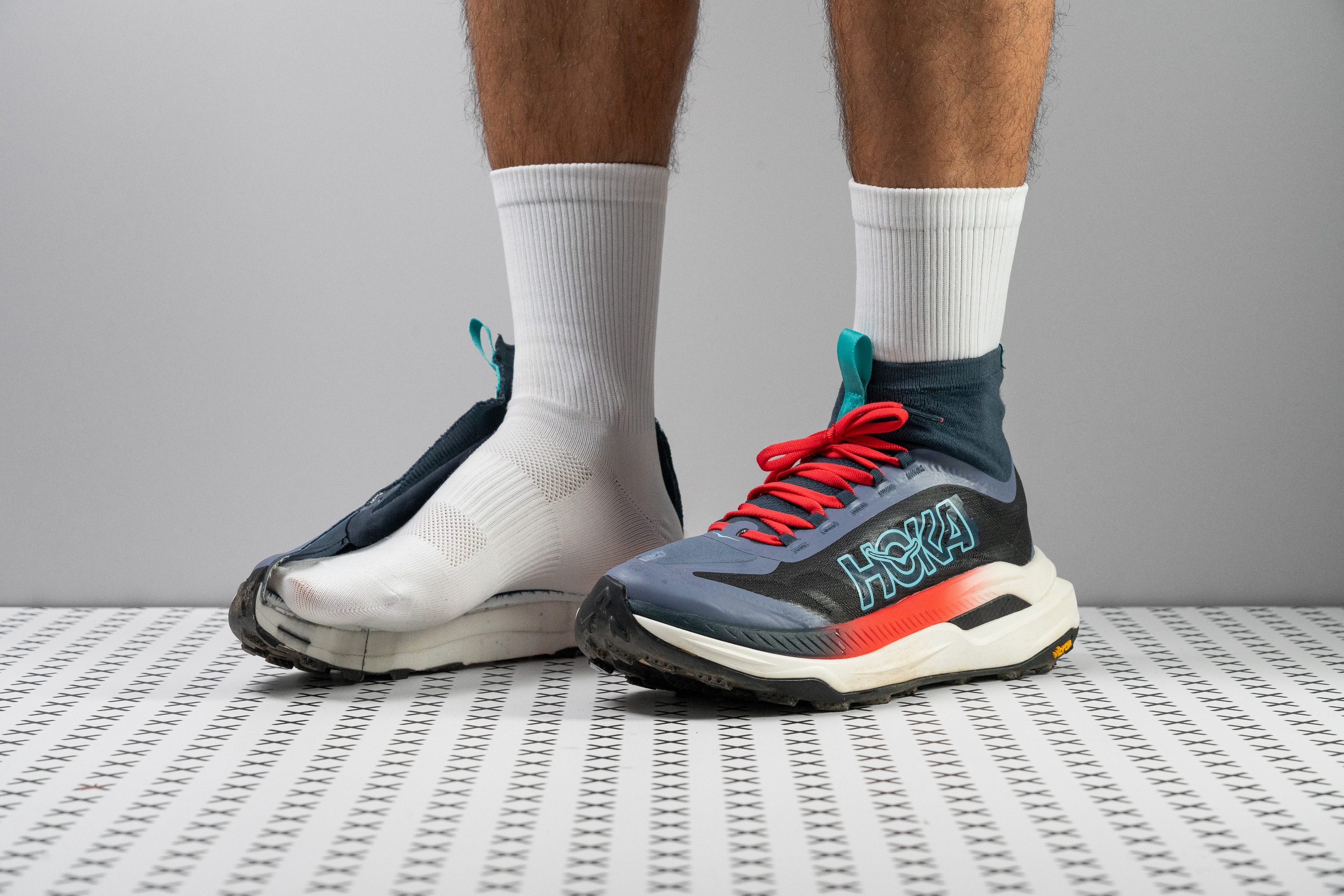


















































What makes it the best?
We tested trail running shoes in and out of the lab and found HOKA’s Tecton X 3 has the best energy return. It satisfies the trail runner’s craving for adrenaline and speed while ensuring a highly cushioned ride. It incorporates a parallel dual-plate design—giving a dynamic experience in a lightweight package.
Designed to be an explosive shoe that keeps us on edge, it feels natural to go all out. We recorded massive energy return scores of 69.9% and 70.2% in the heel and forefoot, respectively, which explains why the midsole kept propelling us forward.
The parallel dual-plate design also contributes to Tecton X 3’s snappiness. It offers the rigidity we want to keep us fast! Our flex test confirms it’s 30.3% stiffer than average, sustaining our speed and quick turnover.
At just 9.7 oz (275g), Tecton X 3 is surprisingly light for a cushioned shoe. Its above-average 37.8/30.9 mm stack ensures comfort for any footstriker. Our shock absorption test validates its impact protection further with high 139/120 SA scores. This exceptional combination mutes out the ground and preserves our legs.
However, this superior performance shoe may burn a hole in the wallet with its $275 cost. Not all runners need to spend this much to enjoy running outdoors.
Pros
- A true supershoe for trails
- Ultra-grippy and durable Vibram outsole
- Fantastic energy return from PEBA foam
- Versatile for both long runs and ultra races
- Stability improvements
- Shields from debris effectively
- Premium MATRYX upper
- Designed to dominate ultra-distance events
- Secure fit
Cons
- Sky-high price tag
- Heavier than the Tecton X 2
- Absolutely not for wide feet
- New ankle gaiter may not work for everyone
Best trail running shoes for racing
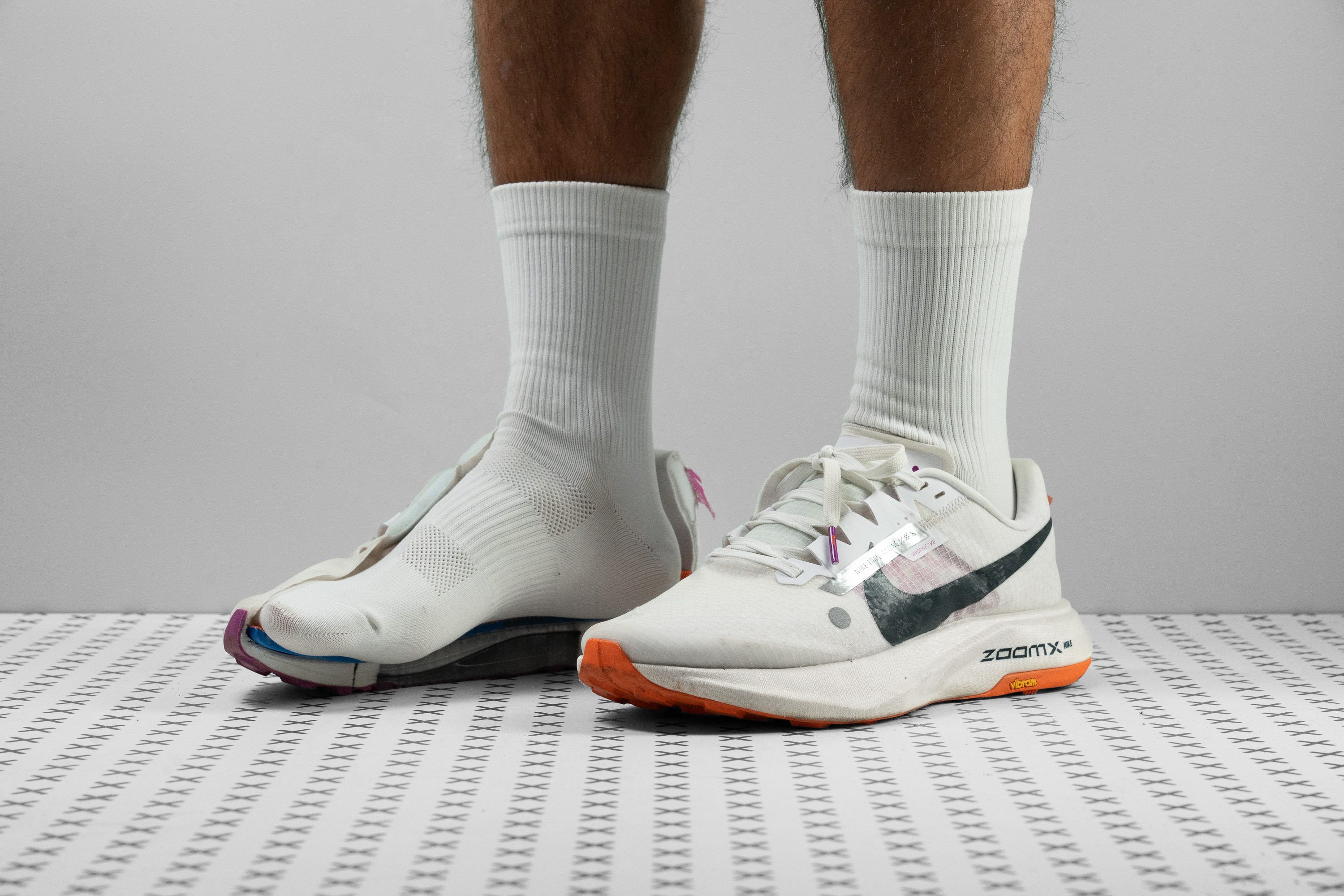



















































What makes it the best?
After extensive testing both in the lab and on the trails, we've determined that Nike’s Ultrafly reigns as the top racer among trail running shoes. It not only satisfies the speedster's thirst for adrenaline but also guarantees a stable and cushioned ride. Offering a Vaporfly-like experience tailored for trails, its world-class energy return and leg-saving platform ensure comfort and speed over any distance.
Ultrafly’s driving force comes from its high level of stiffness. It includes a full-length carbon plate, a rare feature for trail shoes, which our bend test reveals is 38.7% stiffer than average. This translates to energetic toe-offs and insane responsiveness.
What makes Ultrafly a go-to option even for endurance runs is its towering 36.6 mm heel and plush feel. Pressing our durometer against the Pebax foam reveals one of the lowest lab readings we’ve seen—at 9.8 HA, it’s 62.7% softer than average!
Despite its stack, Ultrafly offers a stable ride through its rigidity, wide base, and solid traction. This combination allows for adept navigation of easy to moderate trails, ensuring safety and sure-footedness. Our caliper reveals 10.3/3.8 mm extra width in the forefoot and heel, while the sticky lugs are 3.0 mm deep. We tackled various terrains with balance and control.
This racer’s steep $260 price tag isn’t so appealing given that the average trail runner costs only $137.
Pros
- Optimized for trail races
- Accommodates wide feet with ease
- Full-length, responsive Pebax midsole
- Equipped with a Vibram Megagrip outsole
- Ideal for heel strikers
- Offers outstanding comfort
- Remarkably stable
- Suitable for 100-mile races
Cons
- The Vaporweave upper could be more durable and breathable
- Heavier than expected even for a trail racing shoe
- The $260 price tag might be steep for some
- Limited toebox height
Best trail running shoes for technical terrain
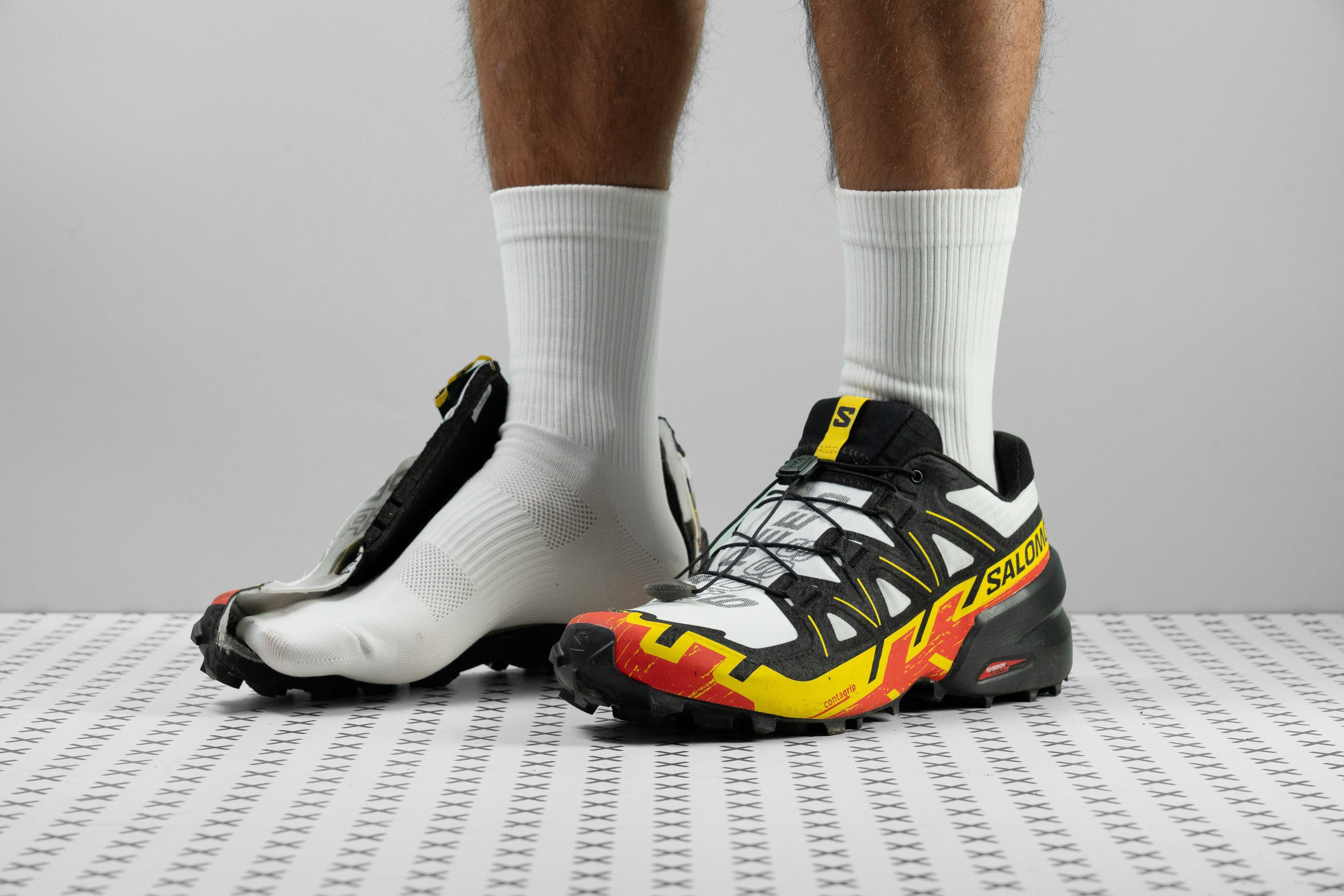



















































What makes it the best?
The Salomon Speedcross 6 emerged as our ultimate trail challenger, excelling in diverse conditions like no other. It features a robust Contagrip outsole and has a supportive platform to secure our strides. Highly agile and grippy, it thrives in fast-paced adventures and dominates technical terrains in the trail running category.
The Contagrip outsole, confirmed at 93.9 HC on our durometer, ensures durability and underfoot protection. Despite being one of the toughest rubbers we’ve measured in the lab, it still delivers remarkable grip on the slickest surfaces thanks to its well-spaced and deep 5.8 mm lugs.
In terms of agility, the Speedcross 6 proved 35.2% more flexible than average in our bend test, enhancing comfort and adaptability on challenging paths. This validated the comfort and control we had in our test runs as the shoe barely resisted our movements.
The midsole, 51.5% firmer than average, offers extra underfoot protection, stability, and ground sensitivity—all of which are crucial for navigating unpredictable terrains safely. The curved insole adds support so that we sit inside it, rather than balancing on top of it.
We don’t recommend this pair to mid-to-forefoot strikers as the drop is a steep 14.1 mm, which may feel too harsh for non-heel strikers.
Pros
- Ideal for heel strikers
- Impressive durability
- Quick mud shedding ability
- Lightest Speedcross yet
- Secure lockdown with QuickLace system
- Enhanced ground feel in the forefoot
- Agile and responsive in fast corners
Cons
- Midsole feels like concrete
- Extremely poor breathability
- Not suitable for midfoot and forefoot strikers
- Low energy return
Best road-to-trail running shoes
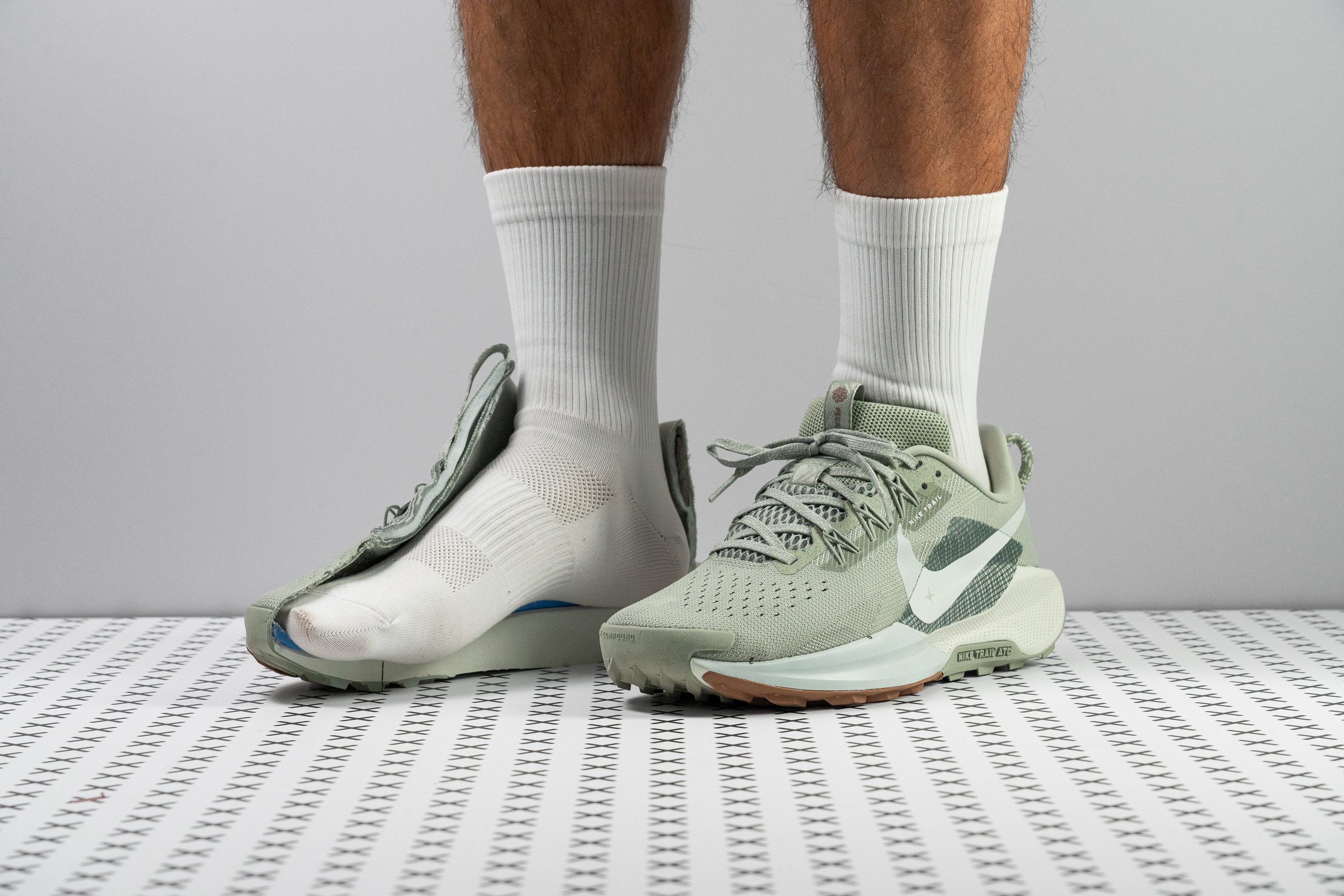






















































What makes it the best?
Cross-checked in the lab, the Nike Pegasus Trail 5 is our top hybrid trail running shoe. During our runs, its reliability and versatility left a lasting impression as we moved seamlessly from the mountains to the streets. It combines the toughness and traction needed for rugged paths with the energy and comfort essential for enduring long miles.
The outsole showed minimal wear after extensive testing and our durometer shows the rubber is a robust 87.9 HC All Terrain Compound. Putting it against our Dremel further confirmed its exceptional resistance, with only a slight 0.8 mm damage. The 3.2 mm lug depth provided excellent grip on moderate paths without feeling cumbersome in urban settings.
Highly cushioned and responsive, our durometer reveals the ReactX foam is 51.1% softer than average. It effectively absorbs landing impact and propels us forward during takeoff, enhancing the overall experience.
Its overall durability ensures it can withstand multiple training cycles. The upper feels padded and incorporates layers of mesh for added protection, as validated by our lab tests. It received a perfect score for durability, as the Dremel barely made its mark. However, ventilation is compromised, receiving only a 2/5 breathability rating that makes it less suitable for warmer days.
Pros
- Fully gusseted tongue
- Reflective elements
- Durable upper construction
- New rockered sole
- Great for heel strikers
- Reasonably priced
- All-around comfort
Cons
- Weight increase
- Possibly too plush for trails
- Still lacks traction
Best budget trail running shoes
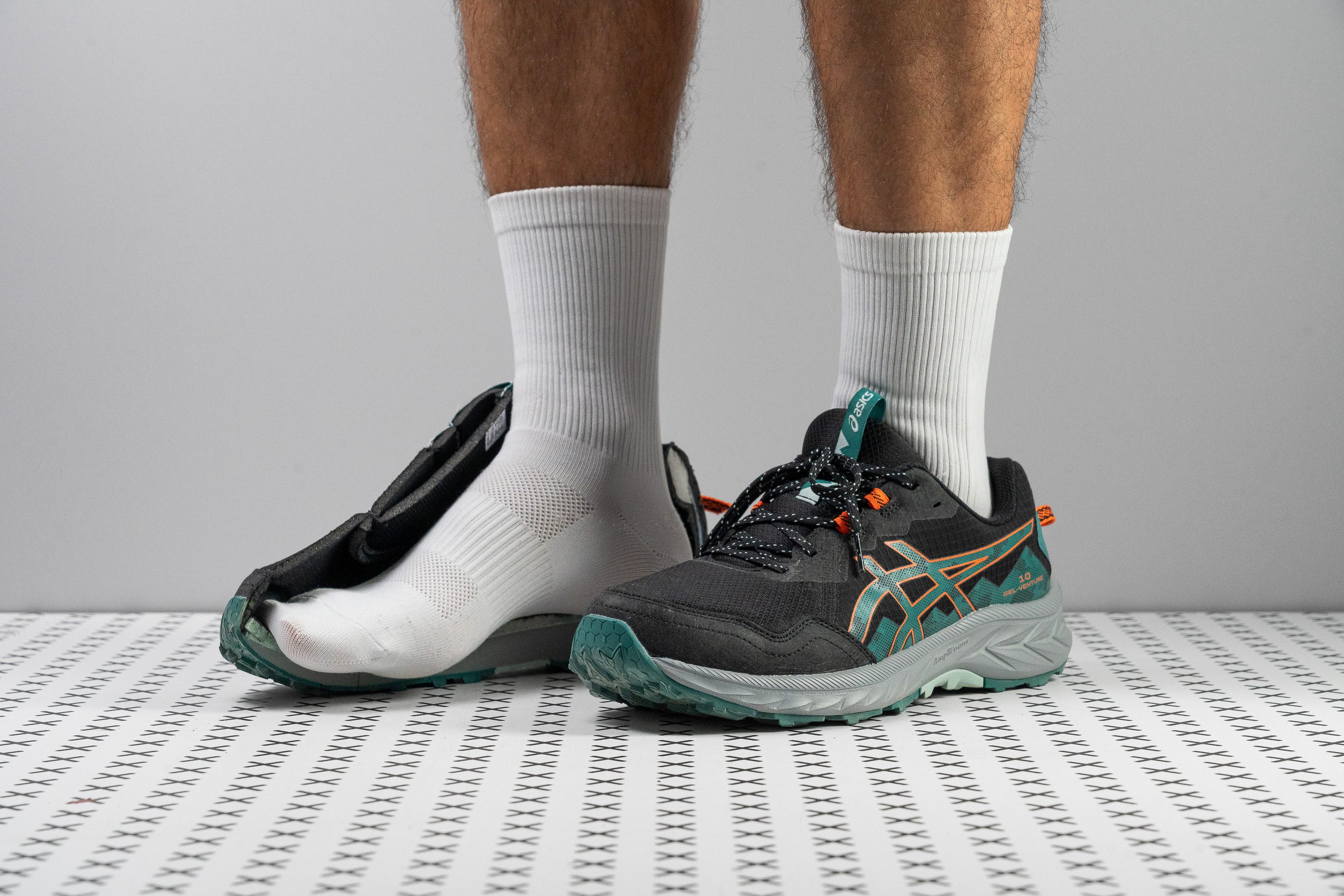











































What makes it the best?
After cross-checking our wear test observations in the lab, we chose ASICS Gel Venture 10 as our best budget trail running shoe. Its fluid midsole and unhampered ventilation show its focus on comfort, wrapped in durable materials for added protection. Priced at a remarkable $80—a 45.9% discount vs. the average trail shoe—it’s hard to beat in terms of value.
GV10 creates an effortless ride through its malleable midsole, which our bend test confirms is 10.6% more flexible than average. We found it easy to maneuver and comfortable even for hikes.
The shoe features a well-ventilated mesh upper that keeps sunlight out and allows the cool breeze in. The material effortlessly allowed smoke to pass through in our lab test, earning a commendable 4/5 rating. This makes it an all-weather friend, even on warmer days.
Contrary to what we expected, the upper also resisted our Dremel bravely, earning a solid 4/5 toebox durability score. Even underfoot, the outsole only shaved off 0.6 mm of rubber, beating the average in terms of wear resistance.
However, given the budget limitations, shock absorption falls short for those seeking a joint-protected and highly cushioned ride. Those seeking maximum comfort can try another pair.
Pros
- Fantastic durability
- Amazing value
- Ideal for beginners
- Softer Amplifoam midsole
- Versatile for trail, travel, casual wear...
- Improved upper
- Plush tongue with pressure-free lacing
- Trail-inspired details at budget price
Cons
- Only for narrow feet
- Heavy
- Low shock absorption and energy return
How to choose trail running shoes
There is no one BEST trail running shoe for everybody. To find the one that’s fine-tuned to your specific needs, you should consider:
- how rugged/technical your typical running terrain is?
- how light, stable, or protective do you want your trail shoe to feel?
- how much cushioning do you need and how soft it should be?
- do you need waterproofing?
We will help you answer these and more questions in this detailed guide on trail running shoes.
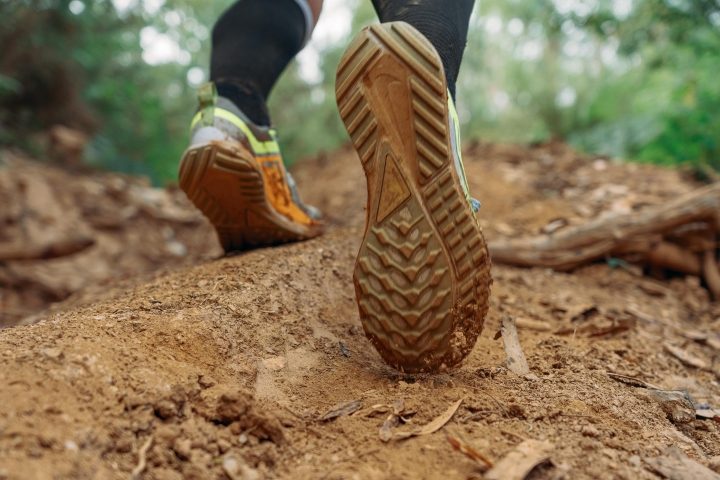
Types of terrains and trail shoes
Trail shoes vary in protection, cushioning, and grip depending on the type of terrain they are meant for.
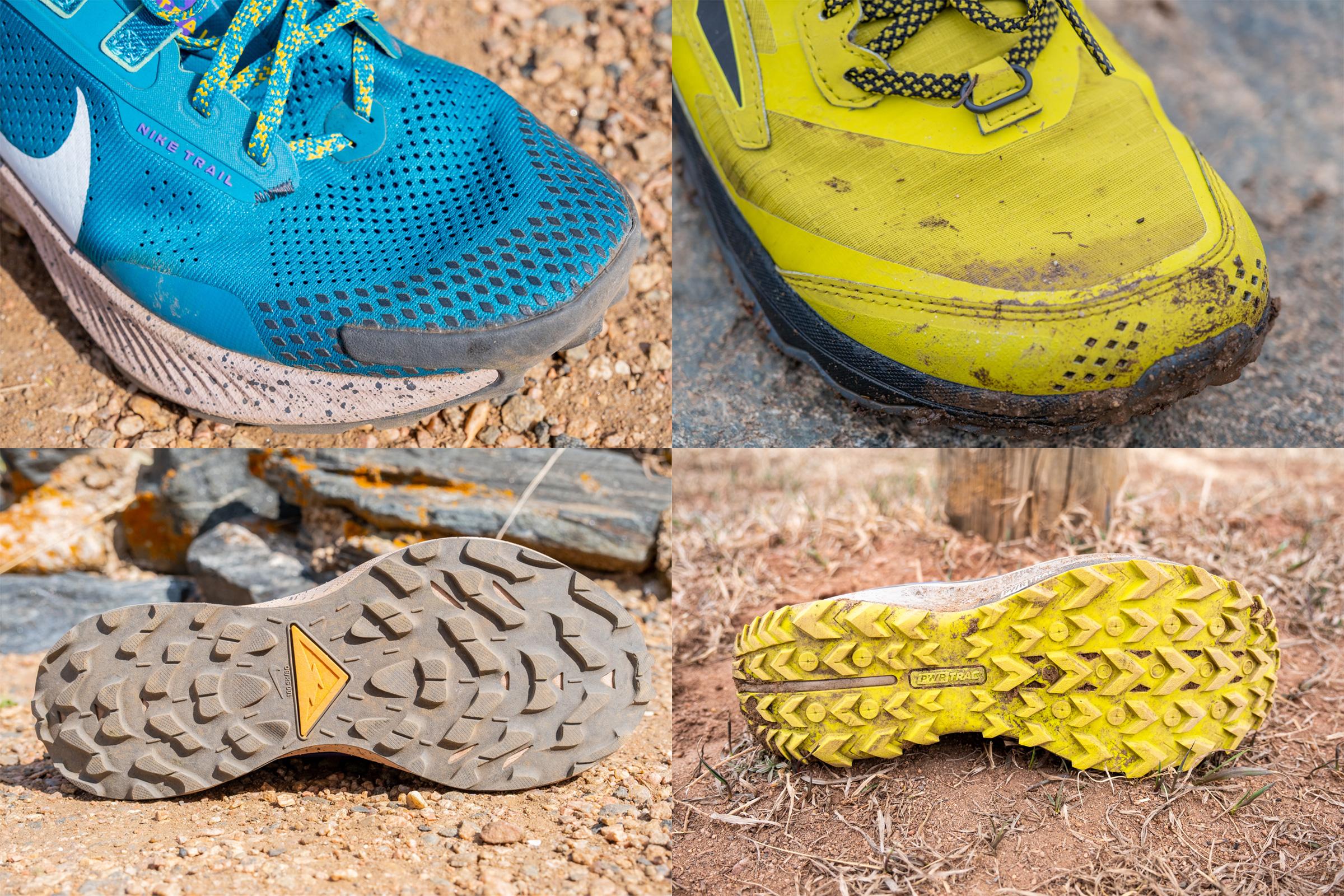
Imagine the terrain you plan to run on most of the time. What does it look like?
- mostly hard-packed and includes pavements
- moderately rugged with some rocks and roots
- highly technical (rocky/rooty), hilly, or soft (muddy) terrain
Example of a light, hard-packed trail
Example of a moderately-rugged trail
Example of a technical trail
Now you can narrow down your footwear options based on the type of terrain:
|
Light terrain |
Moderate terrain |
Technical terrain |
|
shallow lugs (<3 mm) lighter weight less reinforced upper more like road shoes* |
average lugs (3-4 mm) larger toe bumpers thicker uppers some have rock plates |
deep lugs (>4 mm) most reinforced highly durable and protective often with rock plates |
*You can actually use your road shoes for running on hard-packed and well-maintained trails, as long as they have a thick and durable outsole.
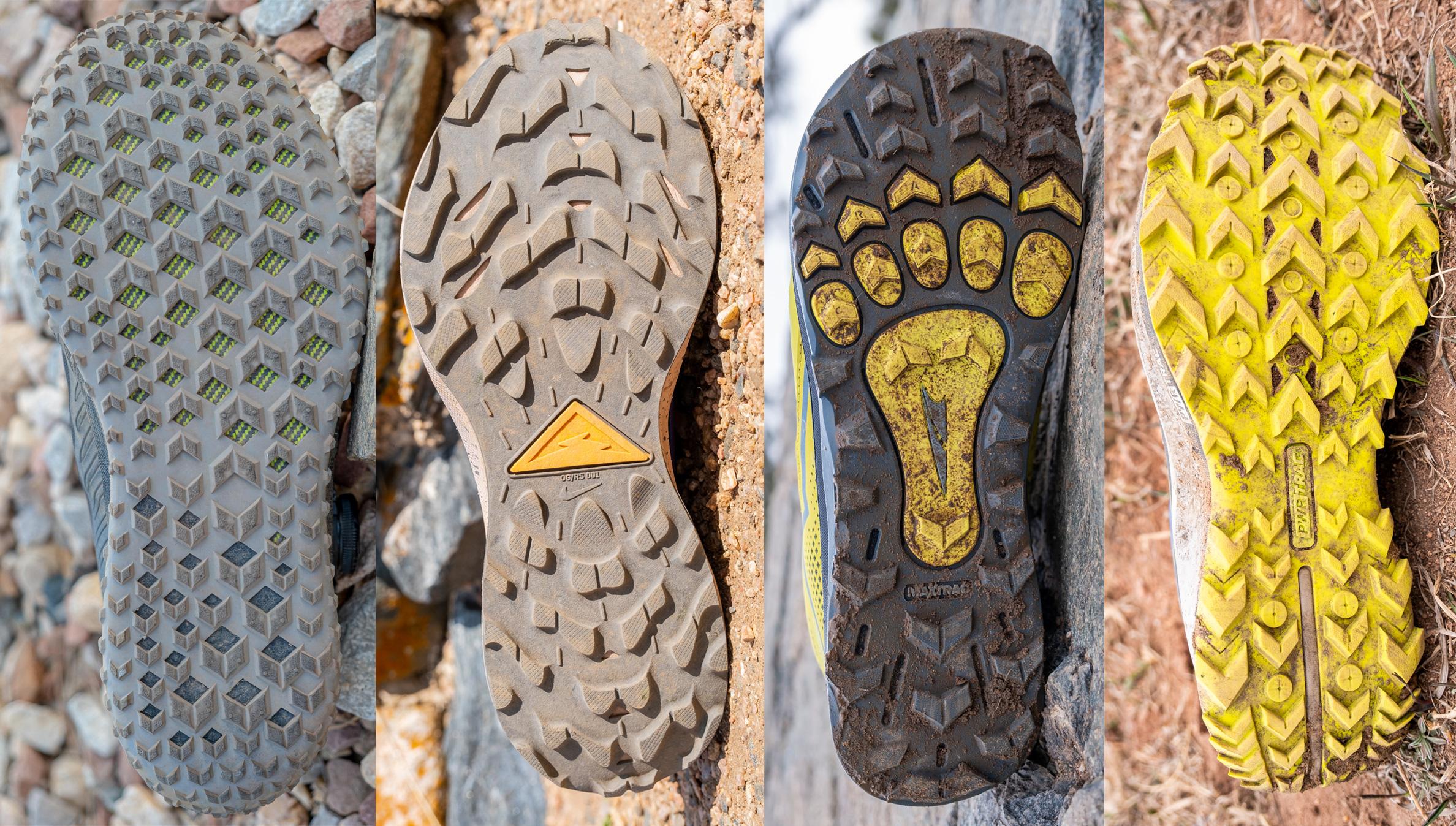
TIP: If you often encounter muddy stretches on the trail, you will need deeper lugs. These lugs should also be placed further apart than usual to shed the mud and not let it cake underfoot.
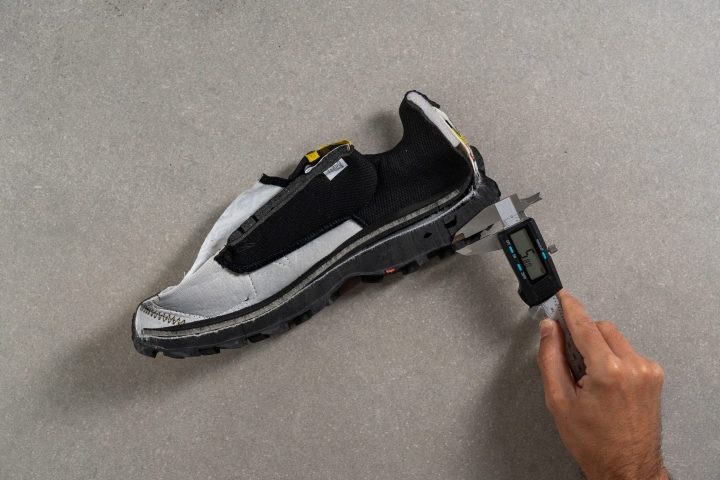
Cushioning in trail shoes: minimalist or max-cushioned
The amount of foam underfoot varies greatly in trail running shoes. The heel stack height can be anywhere from 16 mm to 40 mm, averaging 32 mm.
Trail shoes with less cushioning are lighter and offer better ground contact while more cushioning means better impact protection and more comfortable running.
How much cushioning do you need in trail shoes?
I want to feel barefoot!
Heel stack: <25 mm
Minimalist and barefoot trail shoes offer the most sensitive ground feel but you must be careful on rugged terrain as there is very little foot protection. These shoes are also the lightest but require an adaptation period.
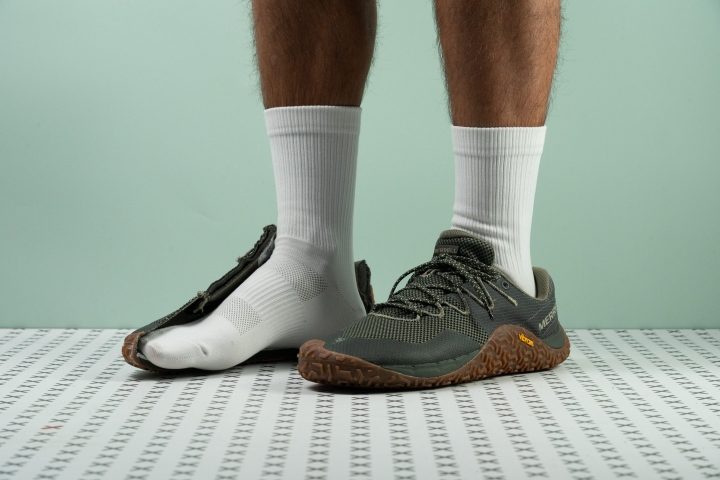
Enough cushion to feel comfortable and protected
Heel stack: 25 - 35 mm
Shoes in this range are considered the best for beginners and most trail runners. Even if there is no rock plate inside, thicker midsoles will protect your feet from impact just fine. Depending on your preference, you can choose between softer and firmer types of foams (read more on that in a section below).
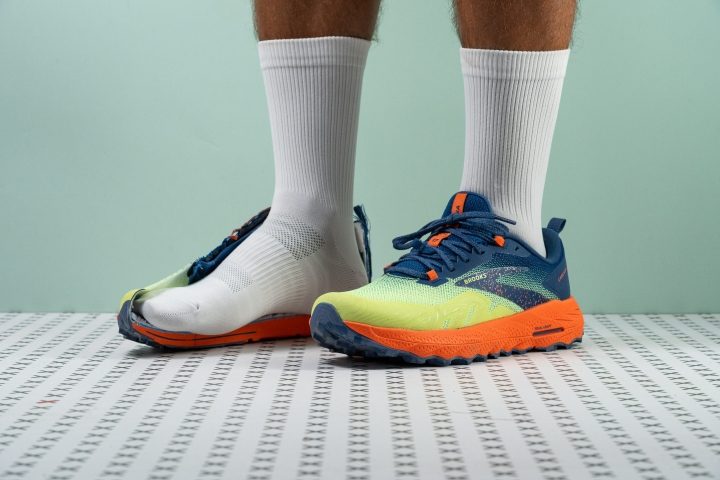
See our full catalog of cushioned trail shoes here.
Tons of foam underfoot!
Heel stack: >35 mm
These trail shoes offer the best impact protection out there but can feel clunky on the foot. Most often, you will find elite running shoes for ultra marathons in this category. As well as avid trail runners who enjoy a super comfortable shoe for easy miles and recovery runs.
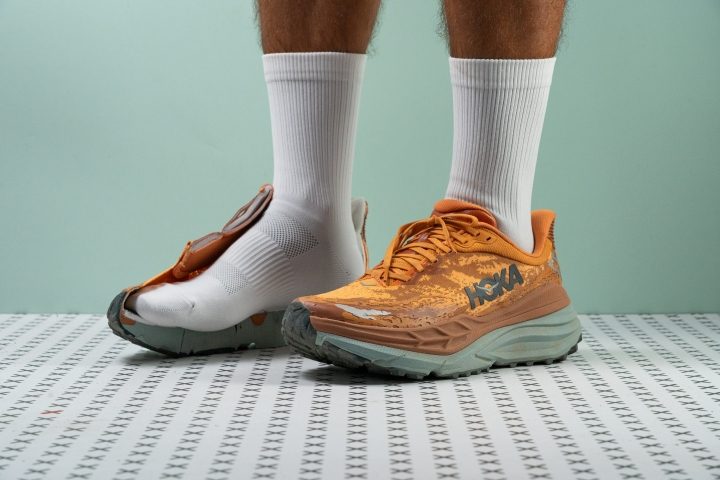
Cushioning in trail running shoes: lab testing the shock absorption
Softer cushioning is better for road-to-trail shoes where more impact protection is vital.
Example of super soft cushioning (185% softer than average).
Firmer trail shoes are better at providing stability on technical terrain. They also do a better job protecting the foot from rocks, roots, and other sharp debris.
Example of extra firm cushioning (22% harder than average).
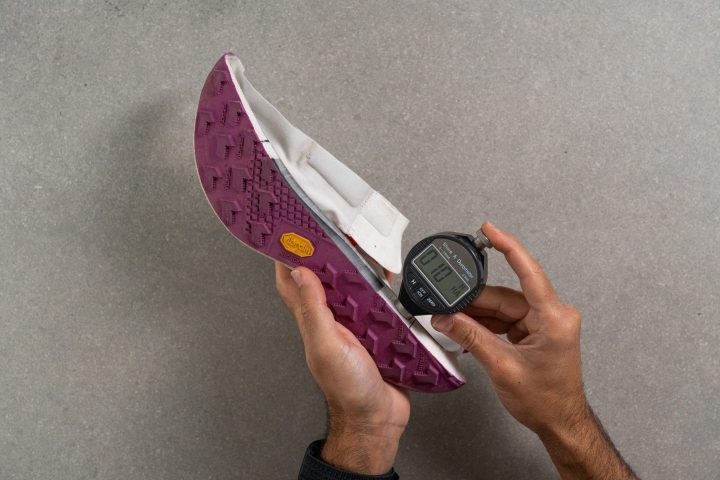
However, cushioning can't be explained by softness only, which is why we test shock absorption in our lab. To do this, we follow the golden standard: ASTM F1976 13. This test tells us which shoes are better at reducing the load on the body (think jumping on a mattress). However, if their energy return is low, they force the legs to use more muscle energy for propulsion.
Shock absorption is described with a measurement in SA and the higher it is, the more impact forces are handled by the shoe instead of the runner.
As you can see, we test shock absorption both at the heel and the forefoot. This allows you to find the best shock absorption for you, exactly where you need it (depending on your foot strike).
Energy return in trail running shoes
While energy return is not directly related to shock absorption, we have to talk about these 2 features at the same time. First, we use the same test to measure both. Second, some shoes can have high shock absorption which ends up in premature bottoming out. So, having a very cushioned and protective midsole can make your legs work more. Hello, premature fatigue.
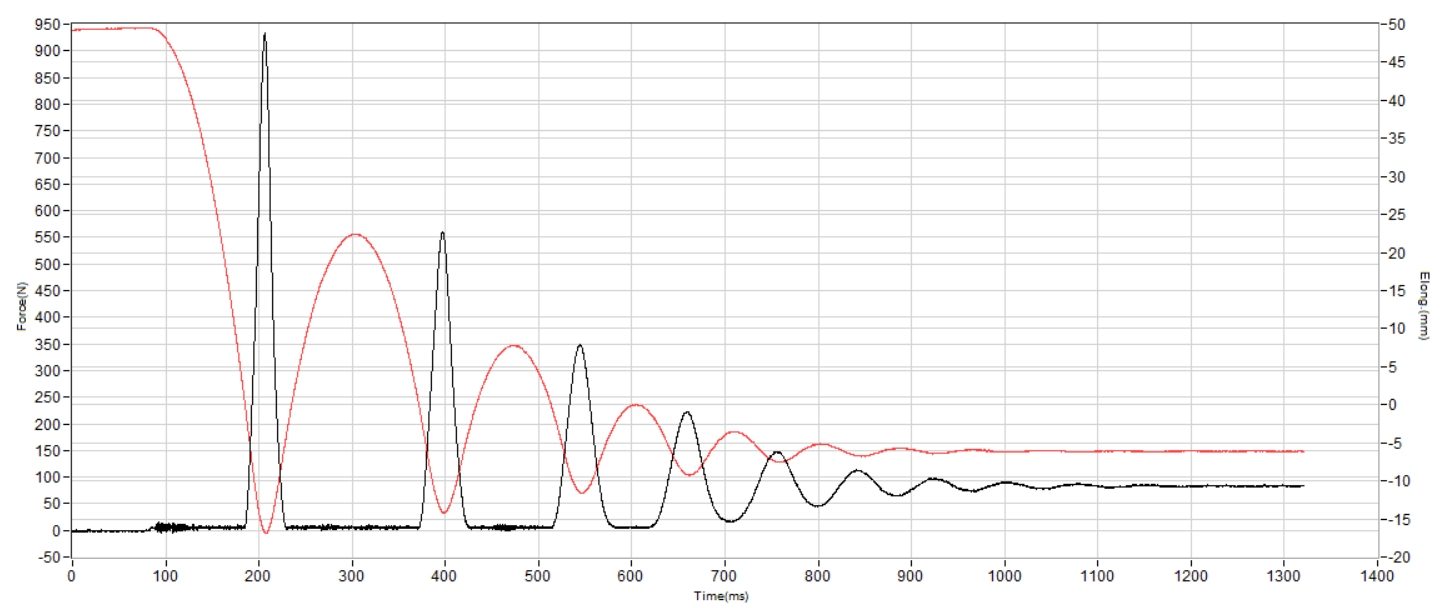
On the other hand, high energy return is great as it is also called a leg-saving feature. The aim is to have both values high (energy return and shock absorption) but, keep in mind that some shoes made for slower runs, jogging, and daily abuse are OK with moderate numbers. Especially if you're a beginner, no need to overinvest in running shoes before figuring out what your legs really need and which goals you are working (running) towards.
Heel-to-toe drop is important to consider
Drop is the difference in height between the heel and forefoot stack. In trail shoes, it can range from 0 to 15 mm, averaging at 8 mm.
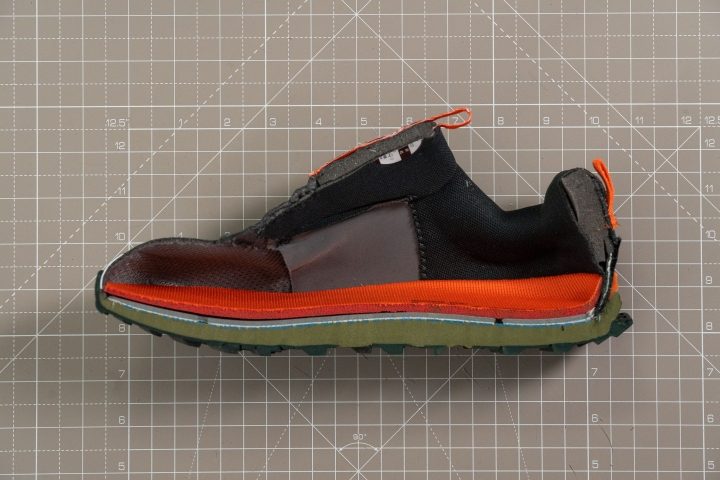
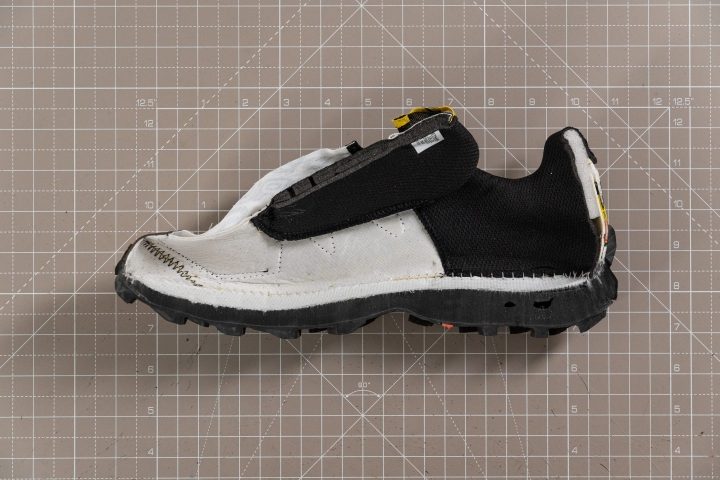
Here are some general recommendations on choosing the right drop for you:
- beginner runners should choose between 8 and 10 mm
- heel strikers (about 90% of runners) should get at least 8 mm of drop
- forefoot/midfoot strikers are better off with 4 to 8 mm
- more advanced forefoot/midfoot strikers prefer 0 to 4 mm for the extra muscle activation and more natural running gait
Avoid drastic changes in your running shoes’ drop as your feet and body need some time to adjust. To learn more about the effects of different drops on running performance, see our in-depth research.
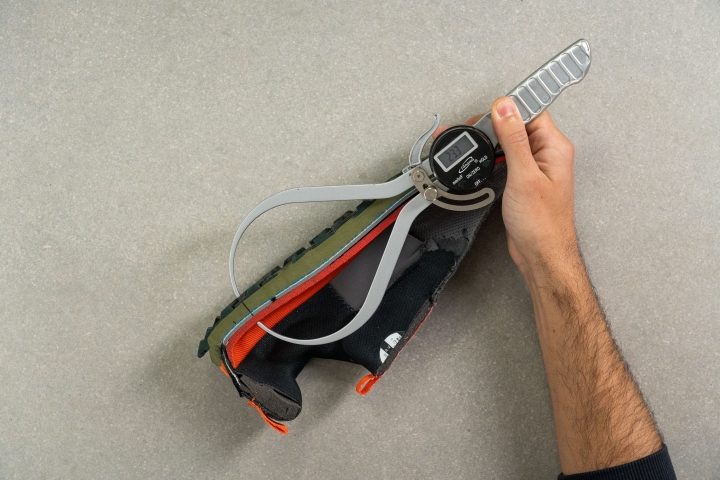
Stability in trail shoes
Runners with flat feet and pronation issues must never ignore this aspect of trail shoes.
Not only does it feel uncomfortable when your feet spill over the edge of the shoe but it is also dangerous and is fraught in injury.
Let’s compare two shoes. Can you feel the difference in stability between them?
These are extreme cases of stability level in trail shoes.
Unlike road shoes, trail footwear has no categorization based on arch support (neutral or stability). But there are a few parameters that can help determine a trail shoe’s stability level:
- torsional rigidity (how stiff the shoe is when you try to twist it)
- heel counter stiffness (how firm the shoe’s heel hold is)
- midsole width (how broad are the widest areas of the shoe’s midsole)
In our lab, we measure each of these parameters for every trail shoe. Our measurements and conclusions are all listed in the Stability section of the lab reviews.
As a rule, more stable shoes have higher scores for torsional and heel counter stiffness as well as wider platform widths.
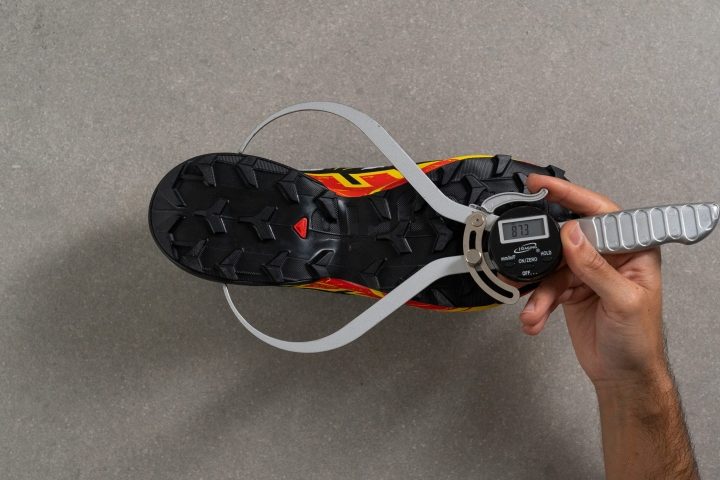
Not sure if you need stable running shoes? Check in our guide on pronation.
Lightweight trail running shoes: pros and cons
The average weight of trail running shoes comes in at 10.4 oz (295g). And over 70% of trail shoes tip the scale at 10 oz (282g) or more. That way, any shoe that weighs less than 10 oz in a men’s US size 9 can be considered lightweight.
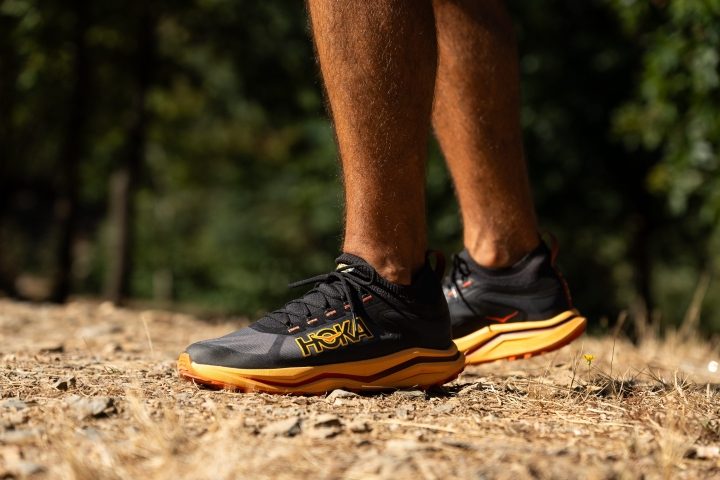
Lighter shoes help you feel more nimble on the trail and more maneuverable with your steps. They also don’t hold you back from picking up the pace. Here is the list of top-rated lightweight trail shoes as of today:
But lighter doesn’t always mean better. These shoes save weight by cutting corners on some other important aspects. They could be less wear-resistant, offer less underfoot protection, or feel less stable.
In the photo below, we compare the upper durability of a 7.5 oz (213g) shoe (top) with that of a 10.5 oz (296g) shoe (bottom).
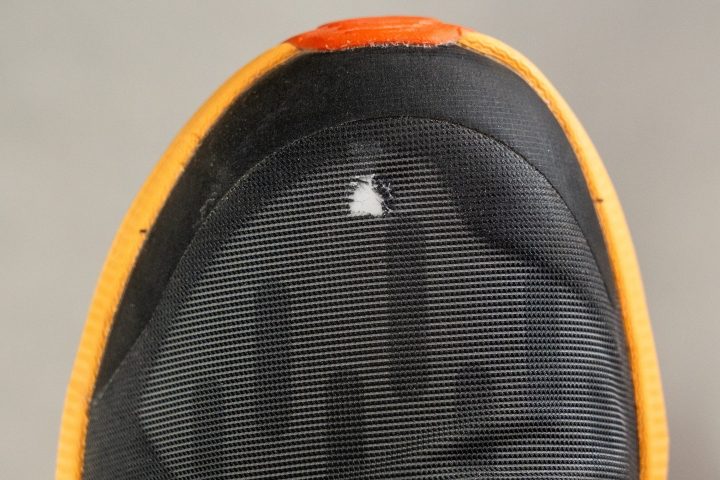
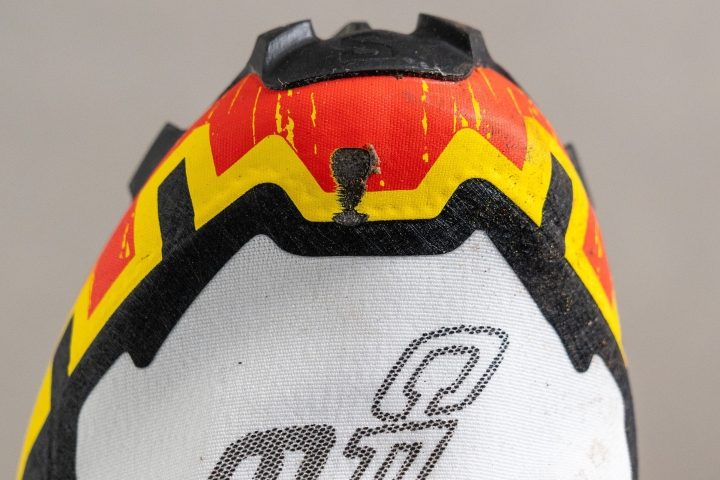
As you can see, the shoe on the left, sacrificed upper durability to save weight. However, this is not necessarily the case for all lightweight trail shoes.
You can find out more about the drawbacks of each shoe in our detailed lab reviews.
Waterproofing in trail shoes
In most cases, waterproofing is NOT necessary in trail running shoes. You should only consider it if you run in rainy, snowy, and soggy conditions regularly.
Otherwise, it is going to feel like overkill. And that’s all because a waterproofing membrane makes shoes:
- less airy or not breathable at all
- overly warm and stuffy
- a bit heavier than average
- wet inside! (if the water spills over the shoe’s collar edges)
Our smoke-pumping machine test shows the difference in ventilation between a waterproof and a non-waterproof shoe
But if you are convinced of the need for waterproofing after all, here is our selection of the best waterproof trail shoes.
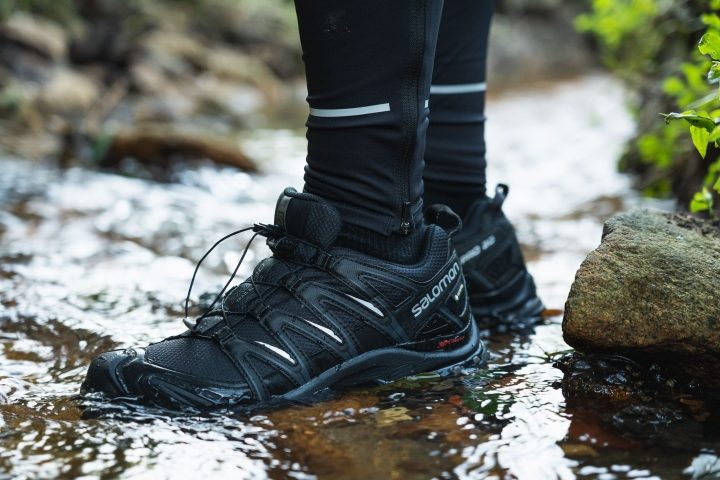
If, on the other hand, you mostly run in warm temperatures, you will appreciate a highly breathable running shoe. Here is the list of the most breathable trail running shoes based on our smoke-pumping lab test:
Trail shoes for cold conditions
Runners who don’t know what “running season” is will surely enjoy warm and waterproof footwear as they transition into the colder months.
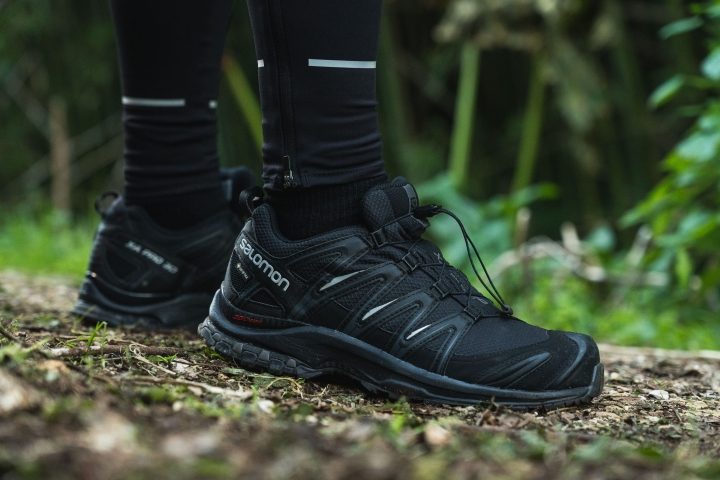
For these brave folks, we keep a special category of winter running shoes. Trail shoes that make it here meet most or all of the following criteria:
- warm upper: low score on our smoke-pumping breathability test (1 or 2 out of 5)
- waterproofing membrane (most of the time, it’s Gore-Tex)
- deep lugs (at least 4 mm) and excellent grip on slick and wet terrain
- they don’t get too stiff and firm in low temperatures
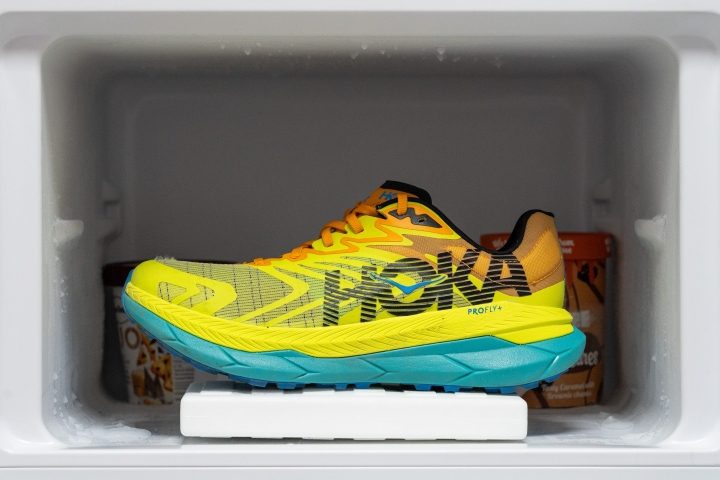
To test the performance in cold weather, we perform our favorite challenge - the freezer test. We keep each trail shoe in the freezer for 20 minutes and then repeat our flexibility and softness measurements for them.
On average, trail running shoes get 40% stiffer and 30% firmer. But the ranges are vast and each individual shoe can change anywhere from 5% to 100%!
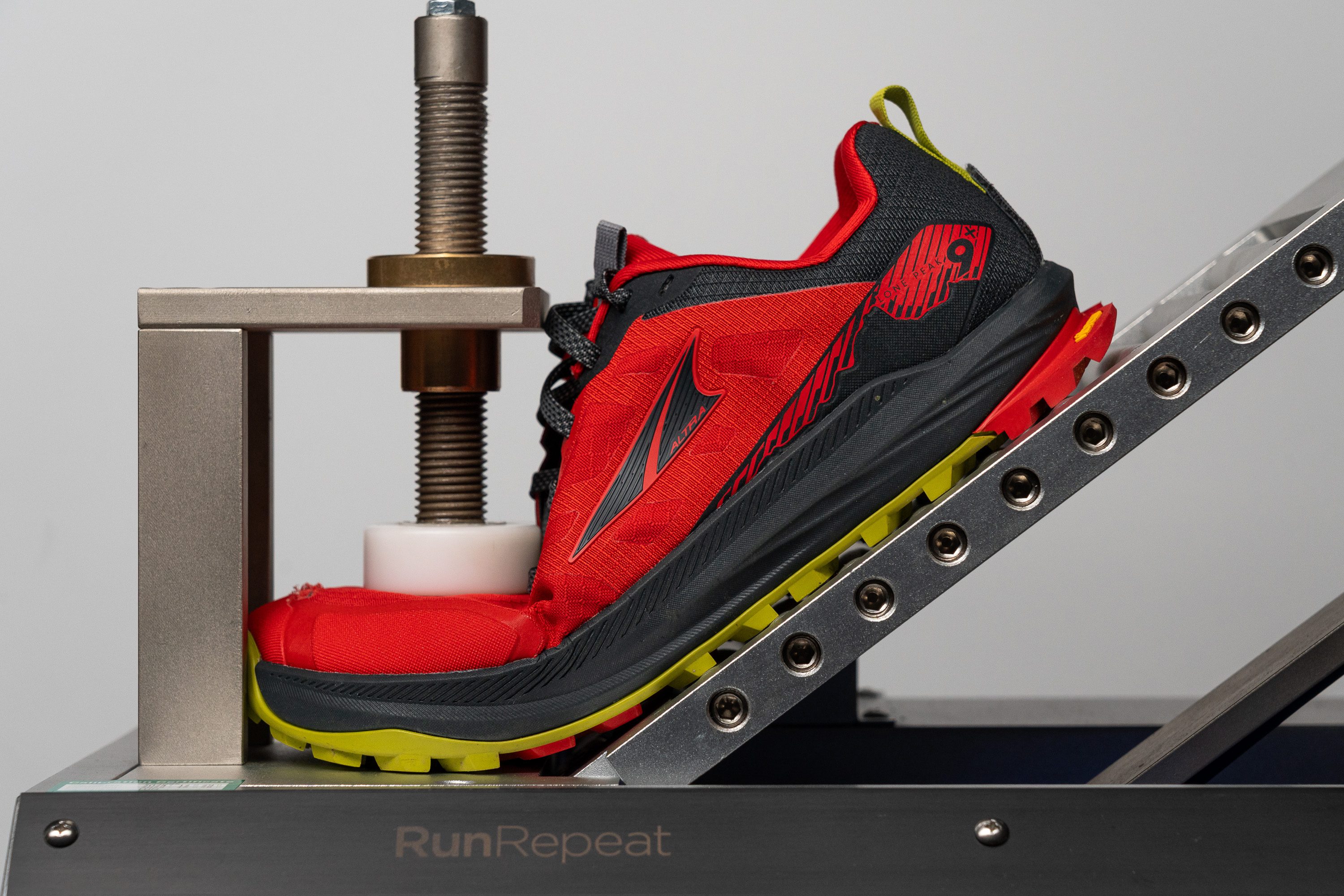
You can check how each trail shoe performs in cold in our detailed lab reviews. You certainly don’t want to end up running on an ice cube in winter!
Finding the best fit and sizing in trail shoes
A poor-fitting shoe is not only painful but it can even lead to foot deformities like bunions, calluses, and more. But luckily, there is a wide range of toebox shapes and widths to choose from.
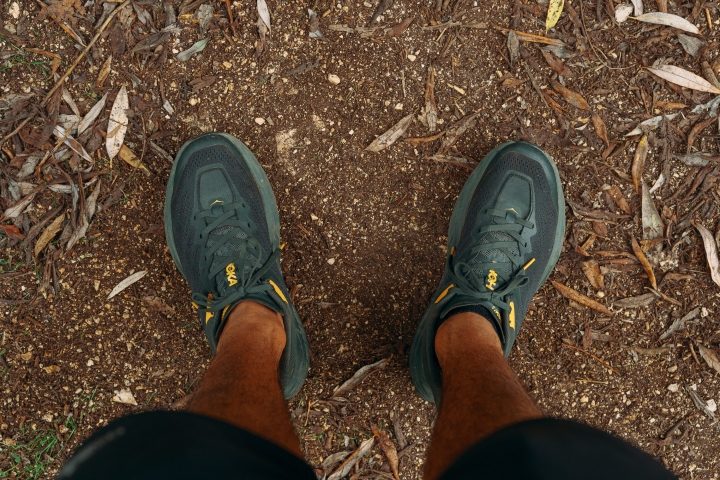
To provide more accurate dimensions of a shoe’s toebox, we measure it in both the widest part of the forefoot and also at the big-to mark.
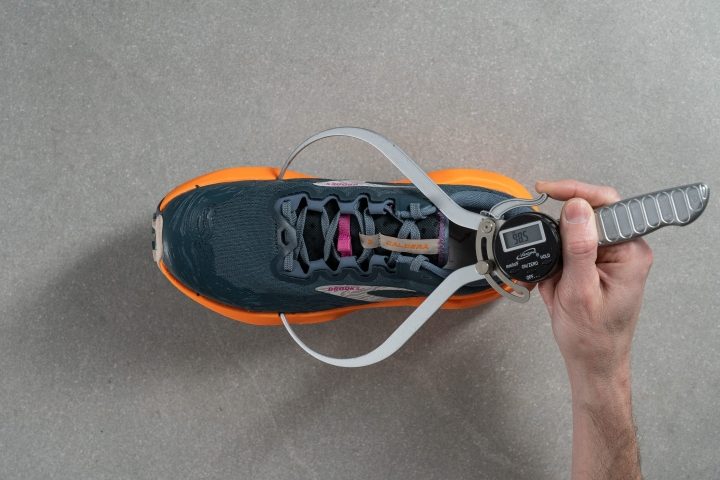
That way we can call the shoe out for having a tapered and narrow fit.
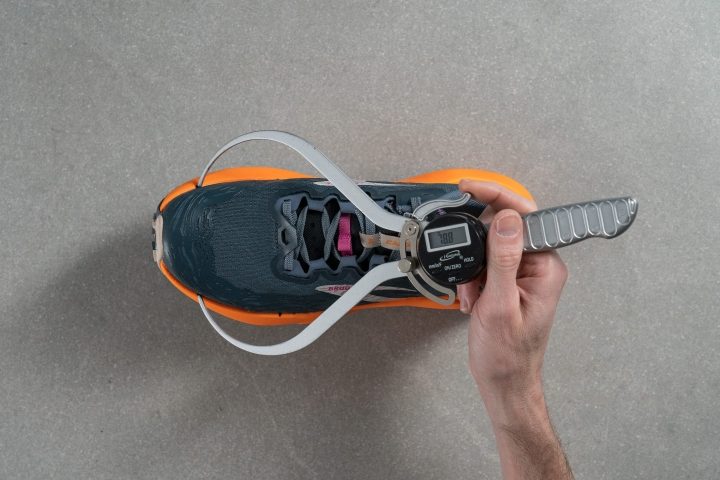
A wide toebox is good if:
- you have wide feet
- you have bunions
- your feet tend to swell
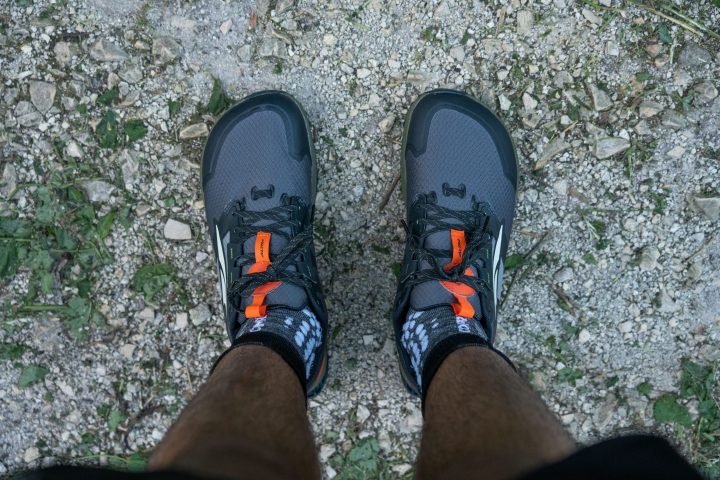
Altra shoes are known for their most accommodating toeboxes.
But too wide of a toebox is not good either. Here is why:
- an extra-wide fit will cause slipping if you're running on mountain hills
- a snug fit is better for races and tempo training runs
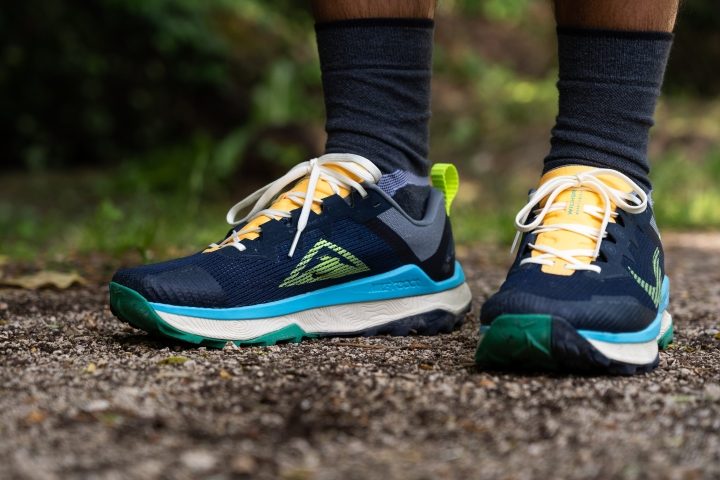
Here are a few tips to help you get the right fit in trail shoes:
- Make sure your toes are not cramped. Your feet swell as you run, make sure to have enough space to prevent blisters or black toenails.
- Sock thickness can affect shoe fit; try the trail shoes with the socks you plan to wear.
- Shoe size changes over time, so it is recommended to measure your feet when you shop for new shoes.
Your regular shoe size in one brand may not be the same in another. Do check with size charts before ordering.
Price
The average price of trail running shoes hovers around $150. Not a cheap buy!
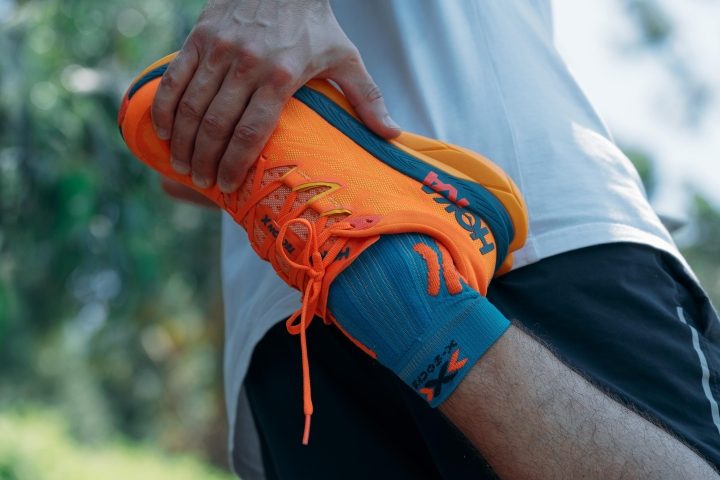
But here are a few tips that could help you save money:
- no need to be loyal to an expensive brand just because it’s “cool”
- no need to get a waterproof (GTX) shoe if you don’t run in wet conditions regularly
- check out the shoe’s previous versions (sometimes changes are minor)
- check current deals and discounts on RunRepeat

